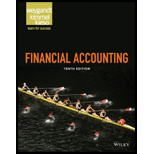
a)
Horizontal Analysis: Horizontal analysis is prepared to make comparison between the financial statements to determine the changes in the financial statements for the previous year to the current year. The changes of the company are measured in dollars as well as in percentage.
Formula:
Vertical Analysis: Vertical analysis is prepared to analyze the relationship among various financial statements with a particular base amount. Use the following formula to calculate vertical analysis percentage:
Formula:
This analysis is otherwise called as common-size statement.
To prepare: Horizontal analysis of Corporation N’s Comparative Balance Sheets data for 2019 and 2018.
b)
To prepare: Vertical analysis of Corporation N’s comparative condensed balance sheet data for 2019.
Want to see the full answer?
Check out a sample textbook solution
Chapter 13 Solutions
Financial Accounting

 AccountingAccountingISBN:9781337272094Author:WARREN, Carl S., Reeve, James M., Duchac, Jonathan E.Publisher:Cengage Learning,
AccountingAccountingISBN:9781337272094Author:WARREN, Carl S., Reeve, James M., Duchac, Jonathan E.Publisher:Cengage Learning, Accounting Information SystemsAccountingISBN:9781337619202Author:Hall, James A.Publisher:Cengage Learning,
Accounting Information SystemsAccountingISBN:9781337619202Author:Hall, James A.Publisher:Cengage Learning, Horngren's Cost Accounting: A Managerial Emphasis...AccountingISBN:9780134475585Author:Srikant M. Datar, Madhav V. RajanPublisher:PEARSON
Horngren's Cost Accounting: A Managerial Emphasis...AccountingISBN:9780134475585Author:Srikant M. Datar, Madhav V. RajanPublisher:PEARSON Intermediate AccountingAccountingISBN:9781259722660Author:J. David Spiceland, Mark W. Nelson, Wayne M ThomasPublisher:McGraw-Hill Education
Intermediate AccountingAccountingISBN:9781259722660Author:J. David Spiceland, Mark W. Nelson, Wayne M ThomasPublisher:McGraw-Hill Education Financial and Managerial AccountingAccountingISBN:9781259726705Author:John J Wild, Ken W. Shaw, Barbara Chiappetta Fundamental Accounting PrinciplesPublisher:McGraw-Hill Education
Financial and Managerial AccountingAccountingISBN:9781259726705Author:John J Wild, Ken W. Shaw, Barbara Chiappetta Fundamental Accounting PrinciplesPublisher:McGraw-Hill Education





